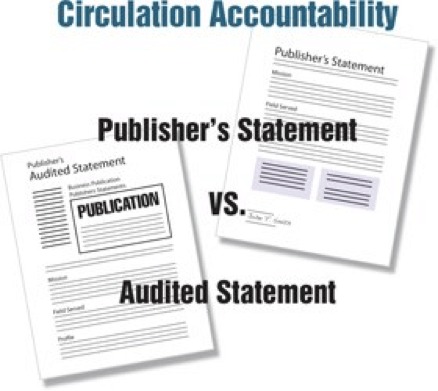What Are Advertisers Buying? Part 4: Audit versus Publisher Statements

Here is Part 4 of our series of white papers covering the disappearance of audits and reader service cards.
From the publishers’ perspective, perhaps it’s largely a matter of cost why BPA or ABC isn’t pursued at the level it used to be: Paying for a full audit to be conducted by BPA or ABC is expensive. This may be why some publishers cut corners by simply issuing a Publisher’s Statement (And, if no one asks for the BPA/ABC, why SHOULD they spend the money?). Interestingly, one of the major publishers stopped their statements a few years ago, and we just got word that they are going back to them!
A publisher’s statement is very different than a formal audit. It’s like saying, “I am an honest person. Trust my numbers” as opposed to having an independent source attest, “Yes, that person is accurate, and the numbers are valid.” Point of view is everything, especially in auditing. An audited statement backed by BPA or ABC is a third-party verification of the circulation’s validity. Think of these organizations as the publication equivalent of bank auditors.
Magazines pay BPA or ABC for their auditing services, which entail conducting independent reviews of these magazines’ circulations. BPA and ABC do not simply take the word of their magazine clients that they reach who they say they do and that the quality of their names is good. BPA and ABC verify whether the circulation is what the publication claims it to be. A Publisher’s Statement, on the other hand, is nothing more than the publisher’s claim that the magazine is sent to certain readers; the statement includes no quality check or verification. “Take my word for it” is the offer. As any engineer will tell you, you should “trust, but verify.” Magazine distribution shouldn’t be any different.
There were a few publications reviewed during Media Days that had not been audited for more than two consecutive cycles — neither in the previous June or December, which are the months when BPA issues its statements. In fact, one publication had done away with BPA entirely. What they offer as a confirmation of circulation was simply a receipt from the U.S. Post Office, indicating how many magazines were mailed in one particular month. Does a postal receipt prove the quality of circulation? No, yet this publication was filled with advertisers! A receipt from the post office offers absolutely no accountability regarding to whom those magazines are mailed. Without an audit or some other proof of a particular circulation, how can advertisers be sure the audience seeing and reading their ads are the people they want to reach?
If a magazine can fill its pages with ads — and the publisher manages to do this without a BPA statement — why bother doing an audit at all? But then, if advertisers don’t ask for proof of what they are buying, why should the publishers do more?
One publisher explained that his company is exploring an alternative to BPA and ABC audits. His argument: BPA and ABC, which have been traditionally strong on the print side, are “archaic” and simply unprepared to effectively analyze e-media. Plus, there are other services to track and validate readership and response. The publisher is looking at other ways to substantiate its e-media audience, such as measuring how “engaged” its readers are compared to other magazines’ audiences (another white paper deals with this topic).
Audience engagement speaks to how invested readers are in the publication in terms of how much time they spend reading and clicking through various section of its website (including electronic ads and sponsorships, of course), which is a way of showing how much its readers care about the property and value what it offers. But “engagement” has nothing to do with “who” is engaged! If I do not specify your product, what good is engagement? BPA and ABC audits have strengths and weaknesses. The jury is still out, however, on whether other services or tools can provide as thorough and objective a review of publishers’ media vehicles, or if there is value demonstrating audience engagement relative to a solid verification of readership.
The problem is this: if advertisers don’t understand their value, they will not ask for them. But isn’t that true of anything? A lack of understanding of value will lead to the disappearance of the object being evaluated. Clearly, between the costs of conducting BPA and ABC audits and advertisers’ dwindling interest in the verification these auditors offer, publishers are becoming bolder about looking into other auditing methodologies or dropping them altogether. In other words, buyer beware.